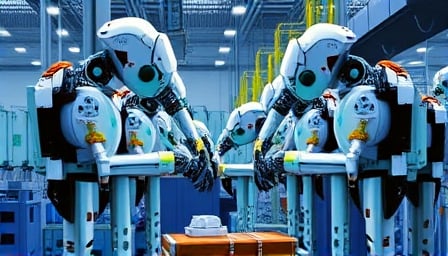Eastmold Co. (NBTM New Materials Group) Surges Amid Robotic and AI‑Driven Market Frenzy
Eastmold Co. has catapulted to a historic high on 17 September, riding a wave of sectoral enthusiasm that has left the broader market scrambling for catalysts. The company’s share price closed at 33.50 CNY, eclipsing its prior 52‑week high of 33.5 CNY and marking an unprecedented rally that has raised serious questions about the underlying fundamentals.
1. Sectoral Momentum: Robots, AI, and Powder Metallurgy
The surge is not an isolated event. Chinese equities linked to robotics and artificial intelligence have been in a state of feverish speculation since early September, with several “robotic” themes—such as Humanoid Robot Concept Stocks—surging. In the same breath, Eastmold’s powder metallurgy business, which supplies components for compressors, electric tools, and automotive parts, has been highlighted as a critical supplier to high‑profile OEMs.
A key driver is the announcement from Eastmold on 15 September that it has secured projects from two leading OEMs to develop “automotive intelligentization products” including Central Control Units (CCUs) and connected‑car modules. Management estimates the total order value to reach RMB 15 billion over the product lifecycle, with mass production slated to commence in 2027.
The company’s strategic positioning in MIM (Metal Injection Molding), P&S (Powder Metallurgy), and SMC (Sheet Metal Casting) platforms further cements its status as a domestic leader, with a 44.38 % market share in the powder metallurgy segment from January‑September 2024.
2. Financial Performance: Growth Amidst a Low P/E Landscape
Eastmold’s FY 2025 first‑half financials paint a picture of robust growth:
- Revenue: RMB 2.93 billion, up 24.51 % YoY.
- Net profit attributable to shareholders: RMB 261 million, up 37.61 % YoY.
- MIM business revenue: RMB 1.207 billion, up 57.26 % YoY.
These figures translate into a Price‑to‑Earnings (P/E) ratio of 40.6, a level that suggests the market is pricing in significant upside expectations. Yet the company’s 52‑week low of RMB 13.26 and current market capitalization of 17.5 billion CNY illustrate a stark discrepancy between the valuation and the fundamentals.
3. Capital Structure and Liquidity Dynamics
On 15 September, Eastmold attracted RMB 60.91 million in financing purchases, accounting for 27 % of the day’s buy‑in volume and signalling confidence from institutional investors. The company’s financing balance of RMB 753 million represents 4.16 % of its free float—a figure that exceeds the 80th percentile in historical data, underscoring heightened investor appetite.
Conversely, the short‑sell balance of RMB 1.11 million and the short‑sell volume of 700 shares indicate that the company remains a target for speculative shorting, potentially foreshadowing volatility ahead.
4. Risk Profile: Speculation versus Substance
The rally is undeniably buoyed by speculative sentiment around robotics and AI chip development. Elon Musk’s public remarks on reviewing Tesla’s AI‑5 chip design and the subsequent frenzy in the “robotic” sector have amplified investor enthusiasm. However, the actual business exposure of Eastmold to the high‑tech AI chip space remains minimal. Its revenue streams are anchored in traditional industrial components, with a notable but still nascent engagement in automotive intelligentization.
The company’s reliance on a limited number of OEM contracts—though lucrative—introduces concentration risk. The projected order value of RMB 15 billion, while impressive, is contingent on future production timelines and market adoption of connected‑car technologies, which have yet to fully materialise in China.
5. Outlook: Momentum or Bubble?
Eastmold’s share price has already achieved 139.97 % cumulative growth over the past year, surpassing the CSI 300 Index’s 44.05 % rise. Yet the P/E ratio remains elevated relative to the broader consumer discretionary sector, suggesting that the market is pricing in a large upside potential that may not be fully justified by current earnings.
The company’s intangible asset base—over 922 patents granted, including 231 invention patents—provides a buffer against commoditisation. Nonetheless, the lack of a clear roadmap for scaling its intelligent vehicle components into mass production raises doubts about whether the current valuation will sustain.
6. Conclusion
Eastmold’s dramatic rise is a classic case of a firm caught in the cross‑fire of speculative enthusiasm and underlying business fundamentals. While the company boasts solid growth metrics and a leading position in powder metallurgy, its valuation is heavily discounted on the back of high‑profile robotics narratives that may not translate into immediate earnings impact.
Investors should weigh the allure of an unprecedented price rally against the structural risks: concentrated OEM reliance, speculative market sentiment, and an elevated P/E that may not reflect sustainable earnings. A cautious stance is warranted until Eastmold can demonstrate a clear, accelerated path from its automotive intelligentization contracts to tangible revenue streams that justify its lofty market cap.
